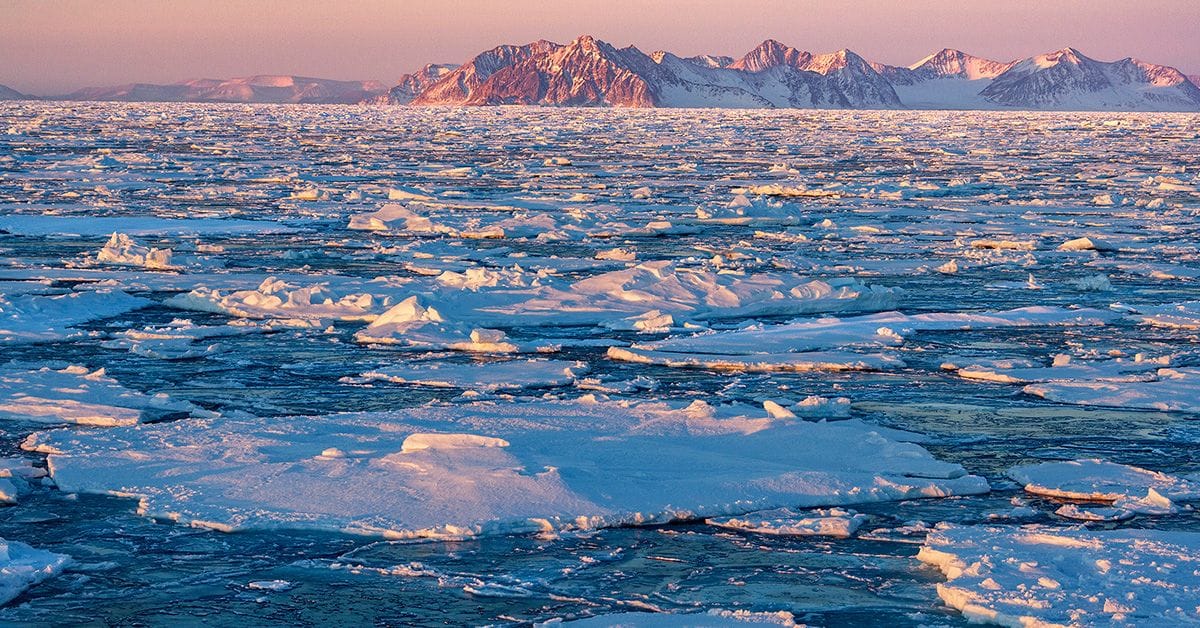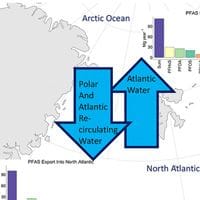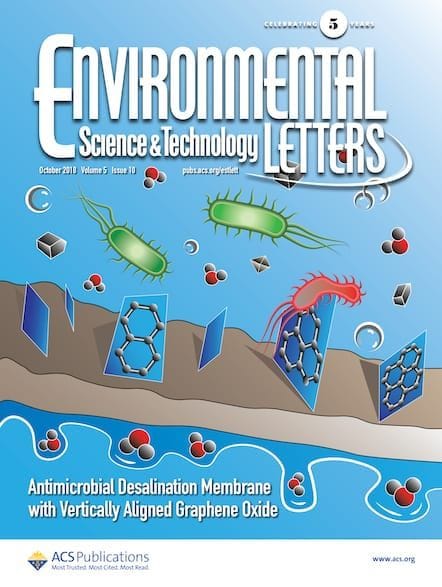PFAS have been recorded in wastewater, rainfall, human blood—and the most remote areas of our oceans. But how do these forever chemicals end up in places like the Arctic, where few people ever set foot? And is that the end of their journey?

Per- and polyfluoroalkyl substances (PFAS) are a class of more than 9,000 anthropogenic chemicals with many applications. They are highly persistent in the environment, and some are bio-accumulative and toxic. Sampling now reveals that they can travel long distances, both in the air and by sea, ending up in remote locations such as the Arctic Ocean. And until now, it hasn’t previously been clear whether the Arctic is a "sink or source" for these forever chemicals.1,2
New research published in Environmental Science & Technology Letters confirms that PFAS in the Arctic are governed by a feedback loop, driven by ocean currents. Researchers from the United States and Germany set out to test passive sampling as a tool across different sites and water depths in the Fram Strait (a deep-sea channel to the northeast of Greenland) and compare PFAS profiles and concentrations of legacy pollutants from the same sites.3 They also wanted to assess whether the underlying sources of these chemicals are changing. These kinds of passive sampling techniques are becoming more popular for this area of research, building on previous work surrounding the use of semipermeable membrane devices to study the vertical distribution of persistent organic pollutants in the ocean.3,4
In the identified feedback loop, it seems that PFAS are delivered to the Arctic via atmospheric transport, exported into the Atlantic through the Fram Strait, and then back again. This works because on the eastern edge of the strait, the West Spitsbergen Current delivers warm, saline Atlantic water into the Arctic Ocean. And in contrast, in the western portion of the strait, cold, low-saline water and sea ice exits the Arctic via the East Greenland Current. The Fram Strait is the only deep connection between the Arctic Ocean and other global oceans.5
Organophosphate esters (OPEs) and polycyclic aromatic hydrocarbons (PAHs) have also previously been shown to have net transport through this same sea channel,6,7 but it is the volume reported that is staggering. The new data suggest that over the course of a single year, around 123 tons of PFAS traveled into the Arctic Ocean and about 110 tons came back into the Atlantic. According to the researchers, these values are the largest of any pollutant reported in the strait, demonstrating the significance of PFAS circulation in the region.3 Two compounds which are being phased out were present at the highest levels, but newer, short-chain PFAS were also routinely present in the samples.

Passive Sampler Derived Profiles and Mass Flows of Perfluorinated Alkyl Substances (PFASs) across the Fram Strait in the North Atlantic
Environmental Science & Technology Letters
DOI: 10.1021/acs.estlett.3c00835
The dominance of PFAS in the ocean is due to their high water solubility, low tendency to bind to organic matter, and extraordinary persistence, resulting in their very slow removal from marine environments. Charting their temporal and spatial trends is important to help understand fate and transport, and also for assessing the effectiveness of national and global chemical management actions.8 Although there appear to be no specific long-term studies of temporal trends of PFAS in water, repeated sampling in six coastal seas, the Great Lakes, the North Atlantic, and the Arctic Ocean has enabled annual median values to be compared over time.7 Previous research also proves that these compounds are being stored more deeply than just surface water—although this may depend on how well particular PFAS adhere to particles and sediment and which may be more prone to sinking (such as those with those with longer chains).9
The authors note that PFAS transport is more complicated than that recorded for other pollutants, since the volatile polyfluoroalkyl compounds may degrade into stable anionic perfluoroalkyl acids in high northern latitudes before export back to the Atlantic. More work will need to be completed before fully understanding the dynamics and long-term implications of this mass movement of chemicals in our oceans.
References
- Sun, C. et al. Depth Profiles of Persistent Organic Pollutants in the North and Tropical Atlantic Ocean. Environ. Sci. Technol. 2016, 50, 12, 6172–6179.
- Joerss, H. et al. Transport of Legacy Perfluoroalkyl Substances and the Replacement Compound HFPO-DA through the Atlantic Gateway to the Arctic Ocean—Is the Arctic a Sink or a Source? Environ. Sci. Technol. 2020, 54, 16, 9958–9967.
- Dunn, M. et al. Passive Sampler Derived Profiles and Mass Flows of Perfluorinated Alkyl Substances (PFASs) across the Fram Strait in the North Atlantic. Environ. Sci. Technol. Lett. 2024, 11, 2, 166–171.
- Booij, K. et al. Passive sampling of nonpolar contaminants at three deep-ocean sites. Environ. Pollut. 2014, 195, 101–108.
- Beszczynska-Möller, A. et al. Variability in Atlantic water temperature and transport at the entrance to the Arctic Ocean, 1997–2010. ICES J. Mar. Sci. 2012, 69 (5), 852–863.
- McDonough, C. A. et al. Dissolved Organophosphate Esters and Polybrominated Diphenyl Ethers in Remote Marine Environments: Arctic Surface Water Distributions and Net Transport through Fram Strait. Environ. Sci. Technol. 2018, 52, 11, 6208–6216.
- Zhang, L. et al. Presence, Sources and Transport of Polycyclic Aromatic Hydrocarbons in the Arctic Ocean. Geophys. Res. Lett. 2023, 50 (1), e2022GL101496.
- Muir, D. and Miaz, L. T. Spatial and Temporal Trends of Perfluoroalkyl Substances in Global Ocean and Coastal Waters. Environ. Sci. Technol. 2021, 55, 14, 9527–9537.
- Savvidou, E. K. et al. Horizontal and Vertical Distribution of Perfluoroalkyl Acids (PFAAs) in the Water Column of the Atlantic Ocean. Environ. Sci. Technol. Lett. 2023, 10, 5, 418–424.
